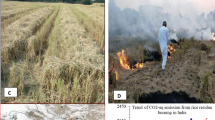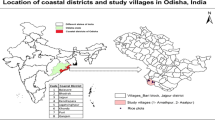Abstract
Cultivation of GW-1 Durum (Triticum Durum Desf, Tetraploid Wheat) under conserved soil moisture condition (CSMC) is unique to the Bhal (saline) and coastal agro-climatic region of Gujarat, India. Popularly known as Bhalia wheat, there is historical evidence that CSMC was in practice since the early 1940s in Gujarat. This nutritious golden colour wheat fetches a higher price for the farmers compared to the irrigated wheat. Drawn from a larger study on geographical indications (GI) in agricultural sector in India, this study found that soil conservation and land preparation practices are rich in traditional knowledge, involve social cohesion and provide employment. Cost of cultivation of Bhalia wheat is less, as it is not susceptible to pests and diseases. However, in comparison with the irrigated wheat, the yield from CSMC wheat is relatively less. Besides the self-consumption, farmers cater to a small segment of traders and consumers who are willing to pay more and insist on buying the pure CSMC wheat directly from farmers. Changes in the consumers’ preference in favour of readymade flour to make bread, demands from urbanisation, changing climate and the availability of canal water in the Bhal area leading to reduction in area under Bhalia wheat. Though Bhalia wheat has the GI registration in India, the awareness about uniqueness and GI label is limited. Effective use of the GI label to attract consumers based on the nutrition value of the wheat would provide a boost to this sustainable cultivation tradition and prevent cultural erosion.

Source: Wikimedia Commons (u.d.)
Similar content being viewed by others
Notes
Information provided here is drawn from the GI journal (Government of India 2011).
Directorate of Agriculture (u.d.).
Figures in parentheses indicate the percentage of land under unirrigated conditions to the total area under wheat cultivation.
Interviews with the scientists from Anand Agricultural University, Anand, who played an important role in filing the GI application for Bhalia wheat.
The objective of GAICL is to ‘protect and safeguard the interest of Farmers and Producers in the state’, the agency became the applicant for Bhalia wheat GI. Its activities include support in providing farm input, training the farmers on harvesting and post-harvest management of agriculture products.
The Indian Council of Social Science Research supported this study titled “Geographical Indication Protected Agricultural Products from the Select States of India: An Enquiry into the Economic, Livelihood and Institutional Aspects,” and the study was done in collaboration with Council for Social Development, Hyderabad.
Sandesh, Anand Avruti 7 April 2018: 3.
According to Article 22.1 of the GI Act, “A registered GI is infringed by a person who not being an authorised user (AU) thereof (a) uses such GI by any means in the designations or presentation of goods that indicates or suggests that such goods originate in a geographical area other than the true place of origin of such goods in a manner which misleads the persons as the geographical origin of such goods: or (b) uses any GI in such manner which constitutes an act of unfair competition including passing off in respect of registered GI” (Government of India 1999).
This online survey is part of the larger study mentioned in footnote no. 6 and cited as Lalitha et al. (2020) in the paper.
References
Alagh Y (2016) S R Sankaran and the land question. Rural labour in India: processes and policy options. S R Sankaran Chair Rural Labour, Hyderabad, pp 1–40, March. http://nirdpr.org.in/nird_docs/srsc/srsc-pub-090518-7.pdf#page=30. Accessed 20 Jan 2020
Barjolle D, Marguerite P, Anna P (2009) Impacts of geographical indications: review of methods and empirical evidences. In: International association of agricultural economists conference, Beijing
Bharadwaj K (1974) Notes on farm size and productivity. Econ Polit Wkly 9(13):A11–A24
Bramley C, Bienabe E, Kirsten J (eds) (2013) Developing geographical indications in the South: the South African experience. Springer, Heidelberg
Bose C (2016) Geographical fixity or affective ties: how do artists respond to geographical indications. J Mod Craft 9(2):117–137. https://doi.org/10.1080/17496772.2016.1205277
Chand R, Prasanna PAL, Singh A (2011) Farm size and productivity: understanding the strengths of smallholders and improving their livelihoods. Econ Polit Wkly 45(26&27):5–11
Dev SM (2012) Small farmers in India: challenges and opportunities, WP2012-014, Indira Gandhi Institute of Development Research. Accessed on 20 Oct 2020
Directorate of Agriculture (u.d.) “District-wise area, production and yield of important food & non-food crops in Gujarat state—year: 2015–16, 2016–17, 2017–18,” Directorate of Agriculture, Gujarat State, Gandhinagar. https://dag.gujarat.gov.in/images/directorofagriculture/pdf/APY-2015-16-2016-17-2017-18.pdf. Accessed 10 Sep 2019.
Gaurav S, Mishra S (2011) Size class and returns to cultivation in India: a cold case reopened, WP2011-027, Indira Gandhi Institute of Development Research, Mumbai, October. Accessed 20 Oct 2020
GIR (u.d.) “Statement of Case,” Geographical indications, Geographical Indications Registry, http://ipindiaservices.gov.in/GIRPublic/Application/Details/192. Accessed 18 Nov 2020
GIRa (u.d.) “Form GI-1A of Bhalia wheat”, Geographical Indications Registry, http://ipindiaservices.gov.in/GIRPublic/Application/ViewDocument. Accessed 18 Nov 2020.
Government of India (1999) The Geographical Indications of Goods (Registration and Protection) Act, 1999. Ministry of Law, Justice and Company Affairs, December. http://www.ipindia.nic.in/writereaddata/Portal/IPOAct/1_49_1_gi-act-1999.pdf.
Government of India (2011a) Manual of geographical indications practice and procedure, version 01.11. Mumbai: Office of the Controller General of Patents, Designs and Trademarks & Registrar of GIs, 26 July. 65.
Government of India (2011b) “Bhalia Wheat.” Geographical Indications Journal No. 38. Geographical Indications Registry, February, pp 24–32.
Hayes DJ, Sergio HL, Andrea S (2003) Farmer-owned brands? Briefing paper 02-BP 39. Center for Agricultural and Rural Development, Iowa State University, Iowa
Jena PR, Grote U (2010) Changing institutions to protect regional heritage: a case for geographical indications in the Indian agrifood sector. Dev Policy Rev 28(2):217–236
Jena PR, Grote U (2012) Impact evaluation of traditional basmati rice cultivation in Uttarakhand state of Northern India: what implications does it hold for geographical indications? World Dev 40(9):1895–1907
Lalitha N, Vinayan S (2019) Regional products and rural livelihoods: a study on geographical indications from India. Oxford University Press, New Delhi
Lalitha N, Soumya V, Madhusudan B (2020) Geographical indication protected agricultural products from the select states of India: an enquiry into the economic, livelihood and institutional aspects. Draft report submitted to the Indian Council of Social Science Research, New Delhi, January
Lourerio ML, McClusky JJ (2000) Assessing consumer response to protected geographical identification labeling. Agribusiness 16(3):309–320
Marie-Vivien D (2010) The role of the State in the protection of Geographical Indications: from disengagement in France/Europe to significant involvement in India. J World Intellect Property 13(2):121–147
Marie-Vivien D, Bienabe E (2017) The multifaceted role of the state in the protection of geographical indications: a worldwide review. World Dev 98:1–11. https://doi.org/10.1016/j.worlddev.2017.04.035
Narayanamoorthy A, Bhattarai M, Suresh R, Alli P (2014) Farm mechanisation, MGNREGs & labour supply nexus: a statewise panel data analysis on paddy and wheat crop. Indian J Agric Econ 69(3):320–335
Patel CL, Patel MV (1985) Mottling phenomena and quality of grains of different genotypes of durum wheat grown under limited irrigated conditions. Plant Soil 87:315–318
Patel RH, Patel AA, Bhatt BK (2011) An economic analysis of production and marketing of wheat (unirrigated) in Bhal region of Ahmedabad District, Gujarat. Indian J Agric Res 45(2):122–127
Shah RL, Patel GA (1968) The Bhal tract (Gujarat State). Indian J Agric Econ 23(1):70–78
Soam SK, Sastry KR (2008) Socio-economic implications of GI registration for agricultural and non-agricultural commodities/products in India. National Academy of Agricultural Research Management, Hyderabad
Tregear A, Torok A, Gorton M (2016) Geographical indications and upgrading of small-scale producers in global agro-food chains: A case study of the Mako Onion Protected Designation of Origin. Environ Plan A (Sage) 48(2):433–451. https://doi.org/10.1177/0308518X15607467
UNCTAD (2015) Why geographical indications for least developed countries. UNCTAD, Geneva
Vandecandelaere E, Arfini F, Belletti GA, Marescotti A (2009–10) Linking people places and products: a guide for promoting quality linked to geographical origin and sustainable geographical indications. Food and Agriculture Organisation, Rome.
Vinayan S (2017) Geographical indications in India: issues and challenges: an overview. J World Intellect Prop (Wiley) 20(3–4):119–132
Wikimedia Commons (u.d.) Administrative map of Gujarat with the administrative divisions since August 15, 2013, https://en.wikipedia.org/wiki/List_of_districts_of_Gujarat#/media/File:Administrative_map_of_Gujarat.png. Accessed 18 Nov 2020.
Acknowledgements
This paper is drawn from a larger study titled Geographical Indication Protected Agricultural Products from Select States of India: An Inquiry into the Economic, Livelihood and Institutional Aspects supported by the Indian Council of Social Science Research, New Delhi. The authors express their sincere gratitude to all the respondent farmers who were generous with their time. Sincere thanks are due to Professor Leela Visaria and the two referees of the Journal whose comments helped us to improve the paper significantly. Research assistance extended by Megha Sanghavi, Bharat Adhyaru, Rohit Rawal and Halak Bhatt is gratefully acknowledged.
Author information
Authors and Affiliations
Corresponding author
Additional information
Publisher's Note
Springer Nature remains neutral with regard to jurisdictional claims in published maps and institutional affiliations.
Rights and permissions
About this article
Cite this article
Lalitha, N., Bandi, M. & Vinayan, S. Bhalia wheat in Gujarat: Does geographical indication registration have a role in arresting the decline?. J. Soc. Econ. Dev. 23 (Suppl 1), 93–112 (2021). https://doi.org/10.1007/s40847-020-00137-7
Accepted:
Published:
Issue Date:
DOI: https://doi.org/10.1007/s40847-020-00137-7




